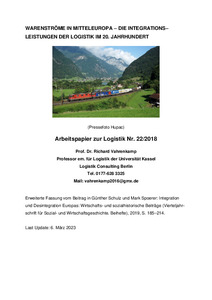| dc.date.accessioned | 2023-03-09T08:52:36Z | |
| dc.date.available | 2023-03-09T08:52:36Z | |
| dc.date.issued | 2018-09-01 | |
| dc.identifier | doi:10.17170/kobra-202303067577 | |
| dc.identifier.uri | http://hdl.handle.net/123456789/14480 | |
| dc.language.iso | ger | ger |
| dc.rights | Attribution-NoDerivatives 4.0 International | * |
| dc.rights.uri | http://creativecommons.org/licenses/by-nd/4.0/ | * |
| dc.subject | logistics | eng |
| dc.subject | history of logistics | eng |
| dc.subject | history of parcel networks | eng |
| dc.subject | mass consumption | eng |
| dc.subject | Switzerland | eng |
| dc.subject | Basel | eng |
| dc.subject | packaged goods | eng |
| dc.subject | less than carload | eng |
| dc.subject | general cargo | eng |
| dc.subject | piece goods | eng |
| dc.subject | railway shed | eng |
| dc.subject | parcel service | eng |
| dc.subject | postal service | eng |
| dc.subject | UPS | eng |
| dc.subject | DHL | eng |
| dc.subject | Federal Express | eng |
| dc.subject | container | eng |
| dc.subject | port Hamburg | eng |
| dc.subject | unpaired traffic | eng |
| dc.subject.ddc | 330 | |
| dc.subject.ddc | 900 | |
| dc.title | Warenströme in Mitteleuropa – Die Integrationsleistungen der Logistik im 20. Jahrhundert | ger |
| dc.type | Working paper | |
| dcterms.abstract | The paper first explains the concept of logistics in the context of the mass consumer society. It uses the case studies of the Speicherstadt in Hamburg and the Rhenania warehouse in Mannheim to describe warehouse management as part of logistics. The article distinguishes between bulk goods and packaged goods. The logistics of bulk goods are explained by the transport services of Rhine shipping and by the transport services of the railways, with tensions in railway policy between France and Germany being outlined. The main part of the paper deals with packaged goods. It shows how packaged goods appeared as a new category of goods in the 20th century and expanded enormously, which had to be distinguished from bulk cargo. The beginnings of packaged goods handling are shown in the Speicherstadt Hamburg. The avalanche-like growth of packaged goods overtaxed the railway as a mode of transport. Subsequently, the expansion of packaged goods transport by lorry is analysed. Cross-border transport reveals coordination problems of the national railway companies. As a segment of the packaged goods market, the rapid growth of the parcel market is described. In addition to the postal service, private parcel services have been operating since the 1970s in Westgermany. The article shows the narrow link in the time series of GNP and parcel revenues that exhibit a coefficient of determination of 98 percent. The paper culminates in the thesis that the extent of the parcel market is an indicator of the high level of development and differentiation of the mass consumer society, as also shown by the low degree in the Eastern Bloc. The paper discusses the unbalance of container traffic in the port of Hamburg and develops an index to measure the unbalance. | eng |
| dcterms.accessRights | open access | |
| dcterms.creator | Vahrenkamp, Richard | |
| dcterms.extent | 68 Seiten | |
| dc.contributor.corporatename | Kassel, Universität Kassel, Fachbereich Wirtschaftswissenschaften | ger |
| dc.subject.swd | Mitteleuropa | ger |
| dc.subject.swd | Schweiz | ger |
| dc.subject.swd | Basel | ger |
| dc.subject.swd | Hafen Hamburg (Hamburg) | ger |
| dc.subject.swd | Logistik | ger |
| dc.subject.swd | Massengut | ger |
| dc.subject.swd | Stückgut | ger |
| dc.subject.swd | Güterverkehr | ger |
| dc.subject.swd | Post | ger |
| dc.subject.swd | Paketdienst | ger |
| dc.subject.swd | United Parcel Service | ger |
| dc.subject.swd | DHL Worldwide Express GmbH | ger |
| dc.subject.swd | Federal Express Corporation | ger |
| dc.subject.swd | Container | ger |
| dc.subject.swd | Geschichte 1901-2000 | ger |
| dc.type.version | publishedVersion | |
| dcterms.source.series | Arbeitspapier zur Logistik | |
| dcterms.source.volume | Nr. 22/2018 | |
| ubks.edition | Last Update: 6. März 2023 | |
| kup.iskup | false | |


